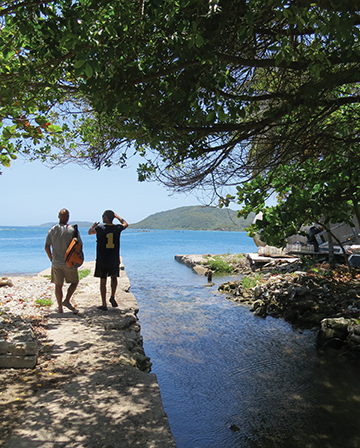- The second part of Barbara and Bram’s exploration of little-known islands (published December 2015)
Four to five knots moving along pleasantly, a fine day of sailing. We had caught tuna and the wind was in our sails, the water was relatively smooth and Bram might actually like sailing today. Most days on the choppy criss cross waves that can be the Caribbean, the mantra of the day is “I hate sailing”, but today was a day to feel great…until a little black cloud settled above us. The evening brought with it consistent 20-25 knot winds and those short mixed waves again. Donna Dee, a 1981 Hughes Columbia 40, rocked and rolled. Bram likes to say “she sails like a brick,” but she is perfect for reefs and shoals and crossing bars. Few boats sail easily in that kind of sea. I love it though, and everything about Donna Dee. But then again, I love anything about boats and being in weather, no day is the same and I feel more alive. I like everything about sailing…well maybe not squall lines coming through repeatedly on my watch during the night. Rough weather continued through the night and in the morning, as I woke from a quick sleep, there, to starboard, was Guanaja.
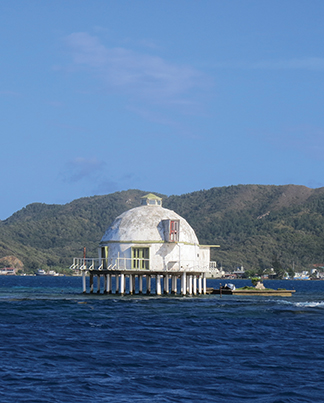
GUANAJA
The Bay Islands of Honduras lay ahead. I woke Bram, “I see land,” I said with glee. “Why did you wake me?” he grumbled, “we have another eight miles, two hours, to the harbor.” He was a little grouchy not having gotten much sleep in the rocky rolly night and maybe a little annoyed at my exuberance so early in the morning.
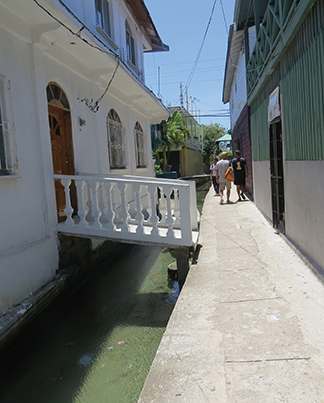
Two hours later, we came though the reef, marked by wooden pilings and a distinctive white dome shaped house. We had arrived at a place no one ever goes, well not so many anyway. Floating as if it were a mirage, was a low island, Bonacca, with houses of pinks and greens, aquas and weathered wood grays. Fishing boats were lined up like sentinels, fishing and lobstering being the base for Guanaja’s economy. We anchored in the sheltered calm inside the reef just off of one of two fuel docks where Bram dropped the dinghy and went to check in.
As usual he also checked out the places to get a first beer, and that is when Red (real name, Trinidad) found Bram. Red Saunders is a native of Guanaja but had the last name of Saunders because his grandfather was one of those who came from afar (New York), fell in love with paradise and stayed. Red was to be our tour guide (one of his many small jobs that “fill the basket”) for the low island where the majority of the approximately 10,000 Guanajas live. Houses were so close together that the threat of fire brings everyone out to fight and defend homes. We wandered the narrow alleys with Red telling us stories.
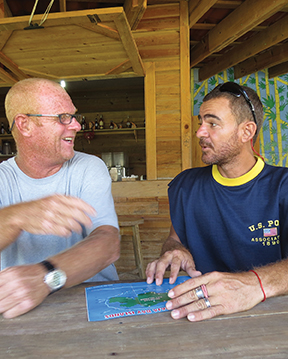
Many houses had been rebuilt after Hurricane Mitch had settled over the island for two days in 1996 and pounded the island with 180 mile an hour winds. We wandered around colorful stilted houses, water surrounding and under many. Guanaja has been called the Venice of the Caribbean with its canals and bridges—as Swan Island is being called the Galapagos of the Caribbean with its pristine reefs. I think that both have merit on their own without the need for comparison. We stop to meet Red’s sister and brother-in-law. Bram had wonderful conversations of common interest; engines, fishing, fishing lures, all in Spanish of which I speak little to none, but their animated conversation can almost be understood without language!
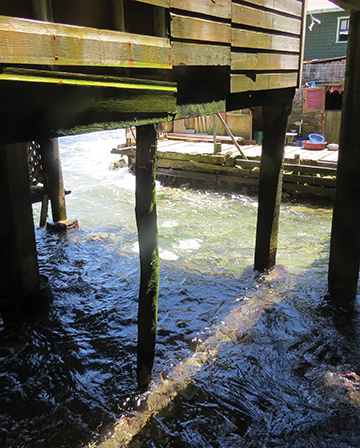
I sat and stared out the window at the beautiful blue of the Caribbean, watching children play freely and happily under the stilted houses. Outside we checked out the 17 foot fishing boat used to catch mahi-mahi, wahoo, tuna, dorado, among other large fish. After saying our good-byes, Red wanted to show us a more affluent area taking us through the little neighborhoods, each having a neighborhood store. We rounded a corner and found ourselves in front of a very large half finished structure. It was in the shape of a ship. It’s owner had been a lobsterman who had run out of money. Bram is always looking at the possibility of things and saying “we could buy that and make it into a…” Red then pointed out an island with a prominent red roofed building and explained that the island had been in the same family for generations. The contracted deed for the two brothers who now owned the island stipulated that the property can never be sold, it can only be passed on to another member of the family. Then Red took us back to a bar for a couple beers. We did find a wonderful tortilla shop that we frequented whenever we came to town. There was a cute little chica making the tortillas. She rarely smiled but when she did it was with her eyes and Bram fell in love. I swallowed my jealousy with each delicious tortilla we had.
EXPLORING THE ISLAND
After our tour of town, a couple beers with Red and checking out Bram’s new island girlfriend, we returned to Donna Dee and moved her to Sandy Bay also called Marina Bay, a well marked anchorage inside the reef and to the northeast of Bonacca. We anchored over a very nice sandy bottom, but don’t look for the marina as there isn’t one. Time to make plans for exploring the mangrove canals and finding the perfect bar, preferably with Wi-Fi.
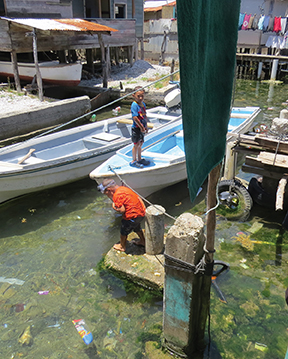
Morning brought another beautiful day in paradise. Bram made yet another great breakfast and we went back to town this time in the dinghy, to replenish the rum, beer and cigarettes. It had become our quest to find the best cheap rum available in places no one ever goes. It was a Wednesday and the major market was closed as were most stores. Thursday is the day that the supply ship comes in and it seems as if everything was closed saving energy for the big market day that would be tomorrow.
After asking a few questions of the locals, a man smiled and motioned us to follow him. He took us to a neighborhood market where we found Plato, a local rum, $12 for a half gallon. Bram’s cigarettes were $2.50. We brought our prizes back to the boat and quickly were back in the dinghy and off to explore the canals through the mangroves.
Riding in a dinghy with Bram was a bit like a high speed motorcycle ride through the mountains on a winding road. The canals actually seemed to be more like watery driveways for homes accessed by boat. One of these canals however, was a bit different. It looked to be a marina that had been stopped mid-construction or may have been destroyed by Mitch as abandoned hulls suggested. Could this be the marina of Marina Bay? As it turned out, the canal with its many side arms, was constructed by a local hotel owner as a hurricane hole for his own boats.
It was time to check out two of the three possible bars that were convenient to our anchorage. The first turned out to be strictly a local bar. The young woman behind the bar was thumbing through the iPod she held, switching quickly from latin song to latin song before they were finished. Two young men, I might say boys, played pool on the other side of the bar. They kept making eye contact with me and smiling. If Bram had his tortilla girl, I had my pool boys. After a beer or two, we knew that this was not “our bar.” We decided to check out the bar called the Manati across the bay. There we found our “Cheers”.
There was a fine cast of the usual suspects. Gar (American) and Brian (Canadian) had each come to the bay about 20 years ago, dropped anchor and had stayed. They had their regular seats at the bar which they predictably filled at 5:00 p.m. each day. Florian, a German had flown in 25 years ago and had come back for every vacation since. He had a hammock with his name on it upstairs from the bar and several children in town who were his godchildren. The proprietors of the Manati, Annette and Klaus, also German, had come to Honduras to open a motorcycle dealership some 20 years earlier on the mainland. Then, the Honduran economy had crashed but instead of going home they escaped to the island of Guanaja to open a barestaurant (as they called it), the Manati, and found their home.
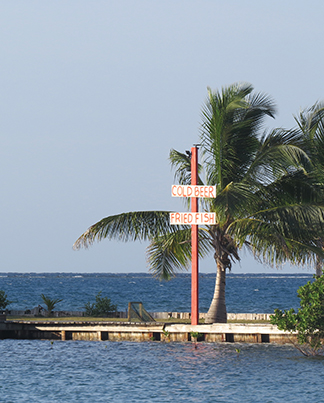
Annette had said that they usually had about 17 boats in the bay in front of the bar at this time of the year. However, this year there were fewer and when we were there, there were five boats and two of them belong to Gar and Brian. Guanaja is not that easy to get to when not coming by boat. To fly there one must first fly to either San Luis de Paolo, then Roatan, then on Thursdays only, to Guanaja. Though I understand that you can pay more to fly in at times other than the regular once a week flight.
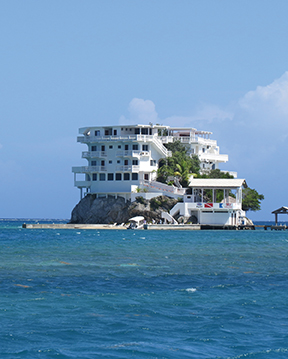
There are several lovely resorts on the beautiful Caribbean blue reef. Diving and snorkeling are excellent as part of this second largest barrier reef system in the world. At the visually interesting Hotel Dunbar, there is diving available for hire. Savanna Bite offers a beautiful aqua setting for beach time, snorkeling, diving or just enjoying the warm sea breeze that wraps around the island.
To shorten the trip to the relatively unpopulated back side of the island, a canal had been built, the equivalent of a highway for commuters. Quiet water, sandy beaches, possible mosquito and sand flea infested stretches of island are up for sale. We play a bit of “what would we do if we bought…” So many interesting possibilities in paradise.
Back through the split in the island I noticed more of the small canals off to the side. The homes that they went to were not visibly evident, the canals were their driveways. So much is hidden here.
The afternoon took us to Savanna Bite for snorkleing. On our way back we spotted on the shore, what looked to be ruins and it turned out to be just that, but recent ruins, not ancient. Another victim of hurricane winds, a deconstructed resort sat in a perfect spot on the edge of perfect blue water. Arched windows spoke to the Spanish influence of the area as did what was left of blue and red tiles around a pool filled with greenish water. Remnants of docks for visiting boats and pools that held fresh fish for dining were outlined on the ocean side. A faded tennis court invited us to a possible pretend game.
What was most curious was the lack of broken dishes or the other artifacts, not even a shard. I poked through the brush and kicked at the refuse inside and no bits or pieces were to be found. Power lines but no road led to the ruins. If this place was to be reclaimed, it would need to to be bulldozed and supplies brought by boat. Another “What would we do with this…” Life is full of so many of these wonderful possibilities.
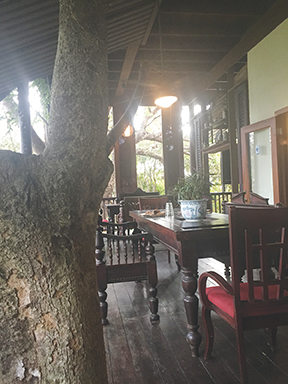
That evening, we wandered over to a resort near our anchorage. We tied the dinghy to the dock and walked up a groomed pathway where we found several cabanas, one with its own pool, and more gardens. The main building was two stories. A lovely veranda of dark wood and colonial appointments, upholstered rockers and tall louvered shutters to block out winds, graced the upper area.
Bram and I sat in companionable silence sipping at beers when suddenly we were accosted with the sounds of wild revelry. What sounded as though a group of Americans had suddenly joined us around the corner of the veranda. Screams of laughter, “Hola” and then “Oh, MY, GOD!” followed again by raucous laughter. Bram went around the corner and there they were, two parrots having a party on their own!
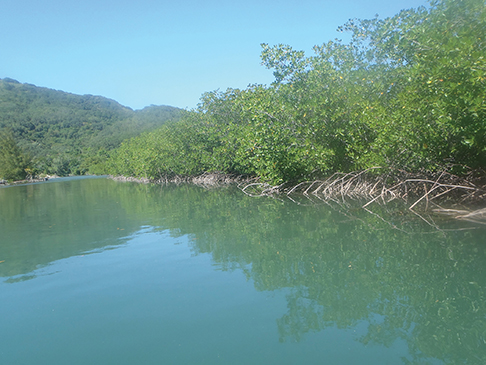
In the morning we took one more trip to Manati. We were getting comfortable here and Bram declared that it was time to leave as he would soon become like Brian or Gar. We planned our escape and were on our way along the southern edge of the island heading west to turn up to the north side for the night. Our next stop would be Tres Puntas just across from the mouth of the Rio Dulce. Bram made chicken and potatoes with peanut butter sauce and mayonnaise, I am told, a Dutch tradition. It was amazingly delicious as was everything Bram put together in the kitchen. Dutch or not I would eat it every day if I could.
Photographer, artist and sailor, Barbara Dahn sails her own Beneteau First 305, Outrageous, on Lake Champlain in the summer and crews with friends including Bram van Dijk on his Columbia 40, Donna Dee, in the Caribbean and anywhere else they wish to go in the winter months.















